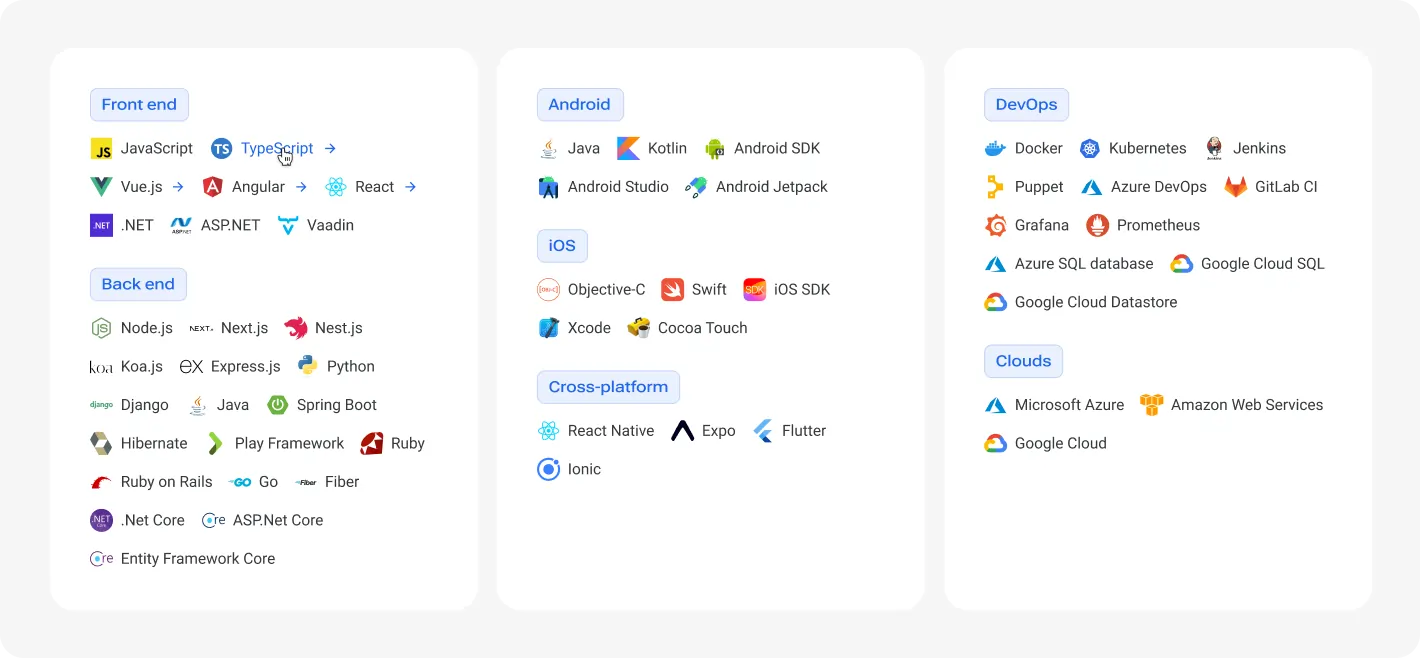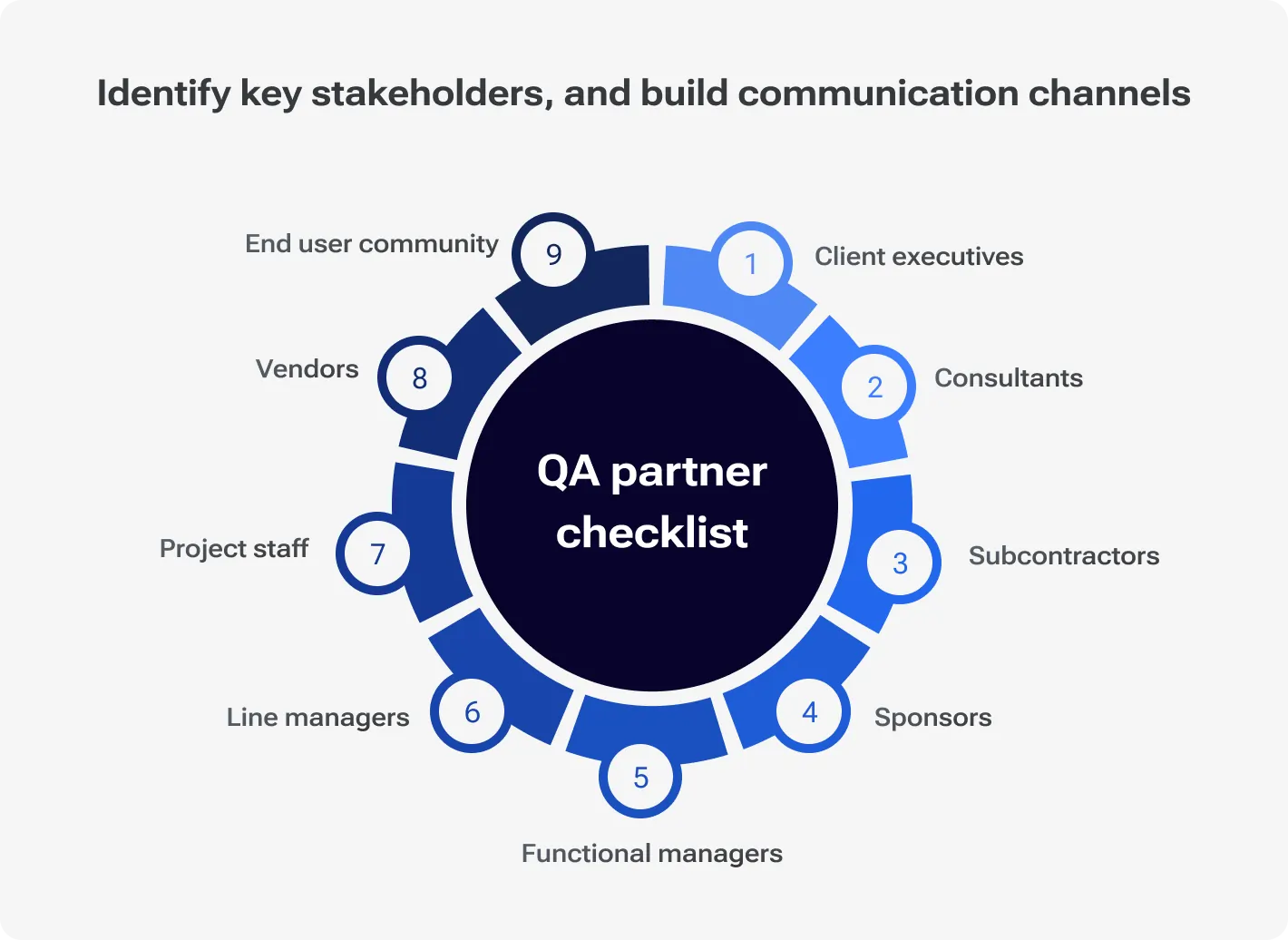There is a saying, “Work smarter, not harder.” The same is true for managing projects. All companies and businesses are on a constant lookout for strategies, approaches, models, and tools that can help manage projects in a smarter, cheaper way. A recent Gartner report found that over 50% of IT projects run over budget because in-house teams struggle with resource limitations. In this case, finding alternatives to in-house teams is one of the smarter ways of handling different projects. As a solution, companies now partner with external teams to tap into specialized talent and achieve significant cost optimization.
Respectively, integrating an effective outsourcing strategy is more important than ever. The simple idea is this: combining the right outsourcing model with precise cost management leads to efficient, sustainable software development.
Flexible trials for staff augmentation and expertise transitioning services
8 key factors influencing outsourcing costs
Understanding the key drivers behind outsourcing rates and outsourcing prices is the first step toward making a cost-effective decision. If you know what particular factors impact the price, you know what variables to deal with. In such a case, several factors determine the final price of outsourced software development. Companies must weigh these elements carefully.
Let's break down the eight core components influencing outsourcing costs. Each one plays a significant role in the overall budgeting process.
Factor #1. Project complexity and its scope
Without a doubt, one of the biggest factors affecting outsourcing costs is the degree of project complexity. In other words, the price depends on how big and intricate the project is. Naturally, having more complex functionalities will command higher prices.
When you have a project with advanced requirements, expect the cost of offshore software development to be on the higher end due to increased development time and the need for specialized skills. Simpler projects with a narrow scope naturally incur lower costs.
To illustrate, imagine, on the one hand, there is a company developing some complex end-to-end enterprise solutions. On the other hand, you have a business that needs a simple mobile app. Working with enterprise solutions involves developing multiple modules, and advanced security features, and, perhaps, involves an integration with some legacy system.
As a result, the scope and level of complexity are critical when assessing custom software development rates and determining the appropriate budget.
Key actions to drive down the price with project complexity and scope:
-
Clarify the project scope upfront.
-
Compare similar past projects for realistic outsourcing cost estimates.
-
Use detailed requirement specifications to get precise pricing from vendors.
Factor #2. Tech stack, frameworks, and expertise
Technology choice plays a significant role in custom software development rates. Projects that require in-demand or cutting-edge technologies — such as artificial intelligence, blockchain, or advanced cloud solutions—often come with premium pricing.
Such a level of expertise needed by developers also influences the cost, as highly specialized skills command higher rates. The specific technology stack you choose, from frontend frameworks to backend programming languages, will directly affect both the software development hourly rate and the overall custom software development rates.
When a vendor indicates a certain degree of proficiency in a particular tech stack and frameworks, it is vital for them to have tangible evidence. In other words, they must have case studies backed up with concrete metrics. The evidence-based approach is critical. In case you work with an outdated tech stack you might be able to decrease costs in the beginning, but won’t be able to scale in the long term.
Key decisions to drive down the cost with tech stack and expertise:
-
Ask for details on the technologies and frameworks the vendor uses.
-
Check if their technical expertise aligns with your project needs.
-
Compare outsourcing rates based on the skill levels and technologies required.
Factor #3. Development team location and geography
The geographic location of your development team is another significant outsourcing cost factor. Software development hourly rates vary considerably between regions. For instance, vendors based in North America typically charge higher rates due to higher living costs, while those in Eastern Europe or Asia offer competitive pricing without sacrificing quality. This difference impacts the overall cost of offshore software development and the software developer per hour rate you might pay.
Region-specific factors must also be considered. These include:
Lower rates in some regions offer clear cost benefits, but they sometimes come with communication challenges. Add longer turnaround times due to time zone differences to the mix as well.
Key geographic-based factors to drive down costs:
-
Request details about the team’s geographic distribution.
-
Compare rates across regions.
-
Consider both cost savings and the potential impact on project coordination.
Factor #4. Engagement models, cooperation types, and pricing strategies
Different outsourcing engagement models impact costs in various ways. The main models include
dedicated team arrangements.
Each model has its own set of advantages and trade-offs. Software developer per hour rate can be different based on the selected model.
For example, a fixed-price model suits projects with well-defined requirements, offering predictable outsourcing costs. A time & materials model provides flexibility for projects with evolving requirements but might lead to variability in expenses. Meanwhile, a dedicated team model works well for long-term, scalable projects and can sometimes be more cost-effective, even if the hourly rates are higher.
When evaluating these models, consider your project's specific needs and risk tolerance. Your choice will directly influence the overall outsourcing prices. It also will help determine the most effective budgeting strategy.
Key aspects that can help drive down costs based on the right engagement model:
-
Understand the pros and cons of each model.
-
Analyze how each model affects cost predictability.
-
Match the engagement model to your project’s lifecycle.
Factor #5. Project management and communication channels
Effective project management and clear communication can significantly influence outsourcing costs. Efficient management is all about minimizing delays, reducing the risk of rework, and helping maintain a consistent quality standard. The vendor’s approach to project management, whether they use Agile methodologies, regular sprint reviews, or modern project management tools, can impact the overall success and cost-efficiency of the project.
In addition, poor communication can lead to misunderstandings and project delays, which, in turn, drive up outsourcing costs. The more communication issues you have, the more project delays will be. It is vital to assess the vendor’s communication protocols and management practices before engaging.
Key project management and communication-related actions to decrease the project cost:
-
Ask for their project management process blueprint.
-
Check which collaboration tools they employ.
Factor #6. Quality assurance (QA) and robust security protocols
Robust quality assurance and stringent security measures are vital in controlling outsourcing costs. A vendor that follows rigorous QA processes, such as
All of the above minimize the risk of defects and costly rework.
In addition, a strong emphasis on security protocols, like encrypted data transfers, multi-factor authentication, and periodic security audits, safeguards sensitive information and protects your intellectual property. Poor QA or lax security can lead to data breaches or product failures. Ultimately, these will drive up expenses.
Key actions to take to make QA and security work for you:
-
Ask for detailed descriptions of their QA services methodologies and testing processes.
-
Check for documented security practices and compliance certifications.
Factor #7. Legal and regulatory full-on compliance
Adhering to legal and regulatory requirements is critical in outsourcing arrangements. Vendors must have robust frameworks in place to meet different standards. This includes
strict confidentiality agreements;
proper handling of intellectual property.
Non-compliance can result in hefty fines and legal disputes. In turn, this will inflate project outsourcing rates. A vendor well-versed in these areas is better prepared to navigate regulatory challenges and protect your business interests.
Key compliance-related factors to drive down custom software development rates:
-
Ask for their compliance policies, audits, and certifications.
-
Verify the legal safeguards included in their contractual agreements.
Factor #8. Vendor reputation and reliability
The track record and reputation of a vendor can significantly influence project outcomes. A vendor with a proven history of successful projects and satisfied clients will likely deliver quality work on schedule.
These are indicators of reliability and consistency:
A solid reputation reduces the risk of unforeseen problems. Besides, it instills confidence that the vendor will handle challenges effectively.
Key aspects in vendor reputation to take care of and decrease outsourcing project costs:
-
Ask for detailed case studies relevant to your project.
-
Check independent reviews and ratings from reputable sources.
The overall cost of outsourcing software development is shaped by multiple factors. While project complexity sets the foundation, each further variable adds to the stack. Respectively, consider tech stack, team geography, engagement model, project management, and communication channels. After project complexity, these are the secondary factors influencing outsourcing rates.
Finally, there are tertiary factors. These include QA and security protocols, regulatory compliance, and vendor reputation. However, if aspects like compliance are mishandled, it can easily become the most costly factor in the project's overall cost.
10 questions to ask your software development outsourcing vendor
Software development outsourcing rates by region in 2025. A geographic-based perspective
In this section, we will look at different outsourcing rates in particular geographic regions. We focus on market data. The key idea is to show how drastically the cost of offshore software development differs depending on the geographic location of an expert or an entire team. Here’s a summary of average hourly rates and the verdict of each given region.
North America
North America shows higher hourly rates due to higher living costs. In turn, there is a focus on quality. The key benefits of North America’s workforce market include
strong cultural alignment;
seamless communication with companies in similar time zones.
Average rates here might be $100-$150 per hour to hire full-stack developers. The higher cost often reflects the quality premium.
Verdict: North America offers excellent quality at a higher price. If quality and close collaboration are paramount, North America may be worth the premium.
Latin America
Latin America is an attractive option for companies targeting nearshore benefits. With relatively lower hourly rates, often around $40-$70 per hour, this region offers the advantage of similar time zones, particularly for U.S. companies. Cultural similarities further enhance its appeal.
Verdict: Latin America provides a balance between cost-effectiveness and time zone compatibility. For companies seeking cost savings without sacrificing close coordination, Latin America stands out as a strong contender in outsourced software development.
Eastern Europe
Eastern Europe is renowned for its deep pool of technical talent along with competitive pricing. Average hourly outsourcing rates in this region can range from $30 to $60 per hour. In any case, it is one of the most cost-effective regions for software development.
The technical expertise here is strong. Many developers are proficient in the modern tech stack - you can easily hire Python developers in Eastern Europe for a fraction of the cost of a US-based employee. The main challenge may be managing communication across different languages. However, talent from Eastern Europe bridging the language barrier fast.
Verdict: Eastern Europe offers a high-quality talent pool at very competitive rates. It is ideal for complex projects. For cost efficiency and quality, Eastern Europe is a top choice among the best offshore software development countries.
Asia
Asia, particularly India, Vietnam, and the Philippines is known for highly competitive pricing. Software development hourly rates often range from $20 to $40 per hour. This region provides a large labour pool with diverse skill sets. While cost-effective, challenges such as language barriers and time zone differences may arise.
Verdict: Asia remains a go-to region for highly cost-effective solutions. However, you may need to invest in bridging communication gaps.
Other regions
Other regions, such as Africa and Australia, also present unique opportunities.
African countries can offer competitive pricing along with emerging tech talent. On the adverse side, infrastructure and expertise may vary.
Australia provides high-quality work with strong cultural alignment for companies based in similar time zones. However, the prices will be close to those in North America.
In the end, it all depends on your budget, requirements, and challenges you can handle. If budget is all you think about, prepare to deal with some language and cultural barriers when dealing with the most competitive prices. If you are after quality at all costs, prepare to pay extra.
Comparing different outsourcing models and looking closely at their costs
When it comes to the cost of offshore software development, you cannot avoid speaking about different outsourcing models. Each engagement approach comes with its distinct operational benefits and cost structures. From the get-go, choosing the right outsourcing model is all about project-related factors like complexity, duration, and risk tolerance.
Model #1. Fixed price
In short, the fixed-price model is the best one for projects having well-defined and precise requirements. Besides, this approach is crucial for projects with clear timelines. The name of the model speaks for itself. You get a fixed price for a defined project with all the parts visible and unmovable. Under the fixed-price model, the vendor offers a set outsourced software development price for the entire project and its parts.
Naturally, when you have aspects like “fixed-price” and “well-defined requirements,” there is little room for flexibility and change. If your project shifts somewhere mid-timeline, you will have a problem on your hands with a fixed price approach. In the end, a fixed price works best when you have deliverables and scope that are crystal clear. You get cost predictability with no room for change. Respectively, choose the fixed pricing when your project requirements are set in stone. Be careful if you are exposed to dynamic environments.
Model #2. Time & materials
The time & materials model offers flexibility by charging based on time spent and resources used. This model is ideal for projects with evolving requirements or when you need to adapt to changing market conditions. Although it provides flexibility, it can lead to variable costs that require careful monitoring.
The time & materials approach is perfect for projects needing iterative development. Yet, it demands constant oversight to control costs. Choose the time & materials model if you value flexibility and iterative improvements. With the model at hand, you can keep a close eye on your budget as the project evolves. Have a greater degree of control in your hands.
Model #3. Dedicated team
The third approach under scrutiny is the dedicated team model. It involves hiring a dedicated team exclusively for your project. This model is ideal for long-term, large-scale projects requiring consistent expertise and high control over the work. While the software development hourly rates might be higher, the dedicated team offers the benefit of deep integration with your business processes and a long-term commitment to your project.
If you look for ongoing support, scalable resources, and quick staff augmentation, it is often worth paying higher costs upfront. When you face a long-term project with a consistent demand for particular skills and talent, choosing a dedicated model is the right solution. Depending on the project, you can scale the team up and down.
How does the offshore time difference work in your favor?
7 ways to optimize software development outsourcing costs
The end goal of any optimization strategy is to get as close to a perfect cost-to-quality ratio as possible. When hitting the fine balance, you have all the chances to hit the sustainable business strategy. Follow the outsourced software development optimization strategies below, and make sure you get the best price for your project.
1. In-detail project planning and smart control
A well-defined project plan is the foundation for cost control. Start by outlining clear scope, deliverables, timelines, and budgets. Such an action helps avoid scope creep mounted with unexpected expenses. Detailed planning allows you to forecast costs more accurately and adjust as needed. The smart thing is to invest time upfront in planning and drafting comprehensive project requirements to prevent budget overruns.
2. Choosing the right software development outsourcing partner
Optimizing custom software development rates is impossible without the right partner at your side. Select a vendor with the right mix of expertise, technical capabilities, and communication skills. It can significantly impact overall costs.
The right partner works efficiently, reducing rework and minimizing delays. With fewer delays and greater efficiency, you get lower costs. Evaluate potential partners using a structured set of criteria. Include past performance and client references. Match your project’s specific needs to the client’s portfolio.
Learn how global healthcare giant relies on us to improve patient outcomes and lower systemic healthcare costs
3. The art of effective communication as a cost-saving strategy
Clear, consistent, and transparent communication is the cornerstone of any project’s success. When these aspects are part of your journey, there is a low chance you’ll face misunderstandings and delays.
Establishing regular updates, and feedback loops, and using collaboration tools can help you catch issues early and save both time and money. Implement regular check-ins. Use collaboration platforms to maintain transparency and bring the cost of offshore software development down.
4. Tapping into Agile methodologies and iterative development
Adopting Agile practices provides outsourcing rates control by allowing iterative development and frequent reassessments. Agile methods help adjust project scope dynamically. They make sure you only spend resources where needed as each sprint builds on previous feedback. Agile practices enable you to respond to changes incrementally. The approach reduces waste and keeps development costs aligned with evolving needs.
5. Performance tracking, monitoring, and analytics
Monitoring your project’s progress with clear metrics is essential for keeping outsourced software development costs in check. Use performance tracking tools to analyze development speed, quality, and resource utilization. This data-driven approach helps identify inefficiencies early and guides timely adjustments. Set measurable performance targets. Use analytics tools to track progress. These enable proactive cost management throughout the project lifecycle.
6. Using the power of automation tools
Automation can significantly reduce manual effort and associated costs. By incorporating automated testing, code reviews, and deployment pipelines, you streamline workflows and lower the risk of human error.
Automation tools not only cut the cost of offshore software development but also enhance overall productivity. Integrate automation into your processes to reduce repetitive tasks and free up resources for higher-value work, contributing to lower overall project costs.
7. Ongoing and regular review with constructive feedback cycles
Continuous improvement is key to cost optimization. Establish frequent review sessions where progress is evaluated and feedback is incorporated. This helps catch deviations early, ensuring that corrective actions are taken before minor issues turn into expensive problems. Schedule regular retrospectives and performance reviews to refine processes and keep the project on track, thereby controlling costs effectively.
The optimization checklist
When trying to optimize costs of outsourced software development, ask yourself these questions. They should be a part of your checklist:
Have you clearly defined the project scope, deliverables, and timelines?
Are budget estimates documented and agreed upon upfront?
Have you evaluated potential vendors based on expertise and past performance?
Did you verify client references and case studies relevant to your project?
Are regular updates and check-ins scheduled?
*Are collaboration tools in place to maintain transparency?
Is the project structured into iterative sprints with regular feedback loops?
Are adjustments made based on sprint reviews?
Have you set measurable targets and KPIs?
Are analytics tools used to monitor progress and resource usage?
Are automated testing and deployment tools implemented?
Is there a plan for regular code reviews and integration testing?
Are regular retrospectives scheduled to identify and fix issues?
Is there a system for continuously incorporating stakeholder feedback?
If the software development hourly rate is too high, there is still a chance to bring down the overall costs of the project. Use the insights above to take control of the cost and maximize the benefits of outsourced software development.
Learn how we developed a backend for the Android and iOS apps for new-breed digital finance app that allows users to buy, earn and grow crypto
The future of software development outsourcing costs
When it comes to looking ahead, one can assume the overall landscape of outsourcing rates and outsourcing costs will evolve. There are certain factors and trends that will guide and impact evolution. Let’s take a look at some of them in greater detail.
Anticipated trends
Technological advancements such as AI and automation are set to reduce manual effort in software development. A recent Gartner report projects that the global market for AI in IT operations will surpass $8.5 billion by 2025. Vendors will likely standardize practices as remote work becomes entrenched, leading to more competitive custom software development rates.
Increasing and harsher regulatory requirements along with data protection standards will definitely raise the costs at the beginning. Compliance and security takes resources. Yet, the more time comes, the greater cost reduction you will experience.
Impact of global economic changes
Certain global economic factors continue to share the outsourcing costs. These include the following:
fluctuating exchange rates;
Recent data from Statista estimates that the global IT outsourcing market is set to grow at a CAGR of 4.5% through 2025, potentially reaching over $400 billion. As a result, regions known for cost-effective development may experience adjustments as market conditions shift. New best offshore software development countries could emerge as top contenders.
The role of remote work
Remote work has now become a permanent fixture in the business landscape. As more companies adopt this model, overhead costs are expected to fall, increasing vendor competition. A recent survey by McKinsey indicated that 70% of IT decision-makers plan to maintain remote work options permanently. This contributes to a gradual decrease in the software developer per hour rate over the next few years. With improved efficiencies and broader access to talent, remote work is poised to drive down overall outsourcing prices.
Hybrid engagement models and vendor consolidation
Naturally, the outsourcing market is evolving toward more flexible hybrid engagement models. Companies increasingly favor a mix of in-house oversight combined with dedicated external teams, allowing them to adapt to changing project needs without sacrificing control.
Recent market research from Grand View Research projects that the global IT outsourcing market will reach nearly $414 billion by 2027, with hybrid models experiencing significant growth. These models let companies leverage specialized expertise on demand while consolidating vendor relationships to simplify management.
To take the most of hybrid engagement models, follow these:
Ask vendors about their hybrid engagement options and how they integrate with internal teams.
Check if they offer scalable solutions that combine dedicated teams with flexible resource allocation.
Hybrid models balance cost efficiency and strategic control, making them a key trend in outsourcing today.
Sustainability and ethical outsourcing
Sustainability and ethical considerations are fast becoming essential in vendor selection. Organizations increasingly opt for outsourcing partners that adhere to robust environmental, social, and governance (ESG) standards. A recent Deloitte survey revealed that nearly 60% of companies now factor sustainability into their vendor decisions.
The market for sustainable outsourcing services is expanding. It is driven by regulatory pressures along with growing consumer expectations. Vendors that commit to ethical practices help reduce reputational risks and often deliver more reliable and long-term partnerships.
Respectively, integrating ethical standards and sustainability into outsourcing is a great way to bring better quality to all parties involved. In such a case, one can expect the future of outsourcing costs will be shaped by these three key factors:
-
technological innovation;
-
economic shifts;
-
normalization of remote work.
In the end, by staying ahead of these trends, companies and businesses can adapt their outsourcing strategies to maintain competitive pricing.
Conclusion
Outsourcing software development in 2025 is as much about managing costs as it is about accessing global expertise. By understanding the key factors influencing expenses you can make informed decisions aligning with your business goals. Data-driven comparisons across regions and a clear understanding of different engagement models will empower you to optimize your spending while achieving high-quality outcomes.
Besides, comparing models like fixed price, time & materials, and dedicated teams reveals trade-offs in cost. Additionally, strategies like detailed project planning, effective communication, and Agile methodologies significantly reduce overall costs.
As you plan your next outsourcing project, remember that optimizing costs without sacrificing quality is key. By focusing on the right factors and adopting strategic practices, you can achieve significant savings and drive innovation in your software development projects.
Ready to optimize your software development costs in 2025?
Contact us to tap into high-quality outsourcing solutions that deliver real results. Our strategic approach ensures efficiency, scalability, and cost-effectiveness — without compromising on quality.
End-to-end solutions with predictable budgets, a time-to-market advantage with budget savings of up to 50%





